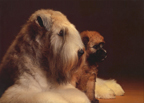Baby Makes Four
By Amy Sugar, D.V.M., B.Sc.
Many of my clients who are expecting a baby are actually not first-time parents. Many have been parents to their furry four-legged children for years.
People are often anxious and concerned over the introduction of a baby to a resident dog who has monopolized their love and attention for years.
As a mom, I truly understand. I had experienced many of these emotions when I was expecting my first child, but as I discovered, there are many things a parent can do to prepare for the new arrival.
Preparing your dog
Just as you’re likely preparing yourself and your house for the baby, you need to prepare your dog. First and foremost, ensure your dog is well trained and will listen to commands from everyone who will be caring for the dog and the baby.
Try to foresee schedule changes that are going to occur in your dog’s life once the new baby comes. Change them now so they’re not associated with the new child’s arrival. For example, if that 7 a.m. walk to the park is not going to happen once the baby arrives, adjust your exercise routine now.
If you’re going to change around the house and access to certain rooms, do it well before bringing your baby home. Set up the nursery and instill the rules now, using praise and food rewards to associate positive feelings with the new furnishings and changes in routine.
Trial run
Expose your pet to tape recordings or videos of babies crying, laughing, etc.
Perform activities with your pet, such as holding a doll and changing the diaper while he sits and stays. Have your dog practise walking nicely beside the stroller, and not jumping onto your lap when you’re holding the doll. Reward proper behaviour. Remember, you don’t want your dog to connect negativity or sudden discipline to the baby’s presence.
Take your dog to the veterinarian for a full examination and counseling on vaccinations, training, dentistry and deworming. Some conditions are zoonotic (meaning they can be transferred from canine to human), so it’s important to make sure any health-related issues are addressed.
Proper introductions
Ask a family member to take some of your baby’s clothes home from the hospital for the dog to smell and to practise ‘care’ activities and training using this new scent.
It’s best for mom to come into the household without the baby to first greet the dog, as the dog will be understandably excited. You could have the dog get used to the baby’s sounds and smells in the house prior to meeting.
Ideally, introduce the dog and baby when they’re both calm and quiet. It’s best to have two people present – one to hold the baby and one to hold the dog. Start by simply having them in the same room together, then progress to allowing the dog to come closer and sniff. You’ll have to use your own judgment about the interaction. Consider using a leash for more control, if needed.
Positive associations
Make sure that you’re not unconsciously associating the baby with things your dog will not like. Are you cuddling, feeding and walking the dog only when the baby isn’t present? Your dog will soon make the connection that the baby being around means less attention, fewer rewards, and possibly confinement. Include your dog in activities with the baby. For example, feed him when the baby is fed or walk the dog when you’re out with the baby in the stroller.
Always supervise the baby and dog when they’re together. Never allow your dog access to the room where the baby is napping. A child should never be left alone with a dog until at least school age.
So many of my clients have been devoted pet owners over the years and eventually become equally devoted, compassionate and loving parents. Your dog and your child will likely form a bond and friendship unparalleled to any other. It’s your job to foster this through preparation, safety measures, supervision and lots of attention and love.

